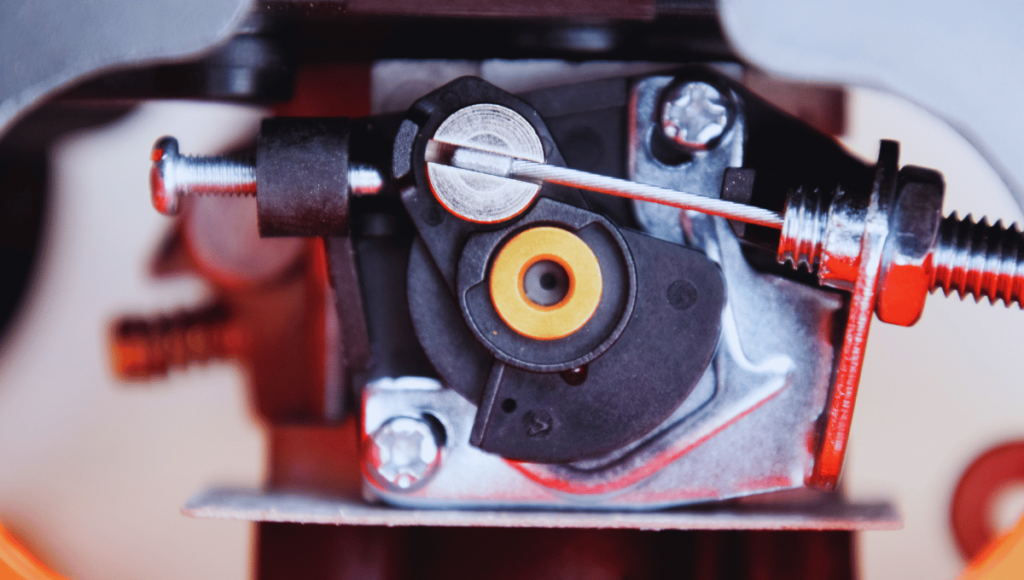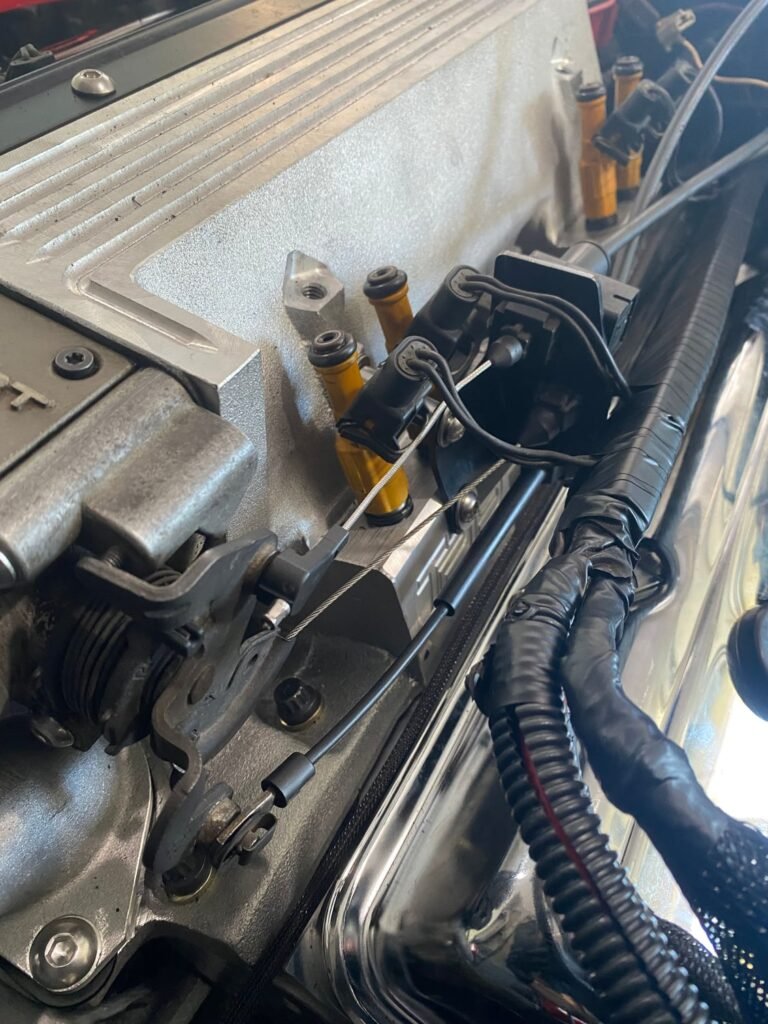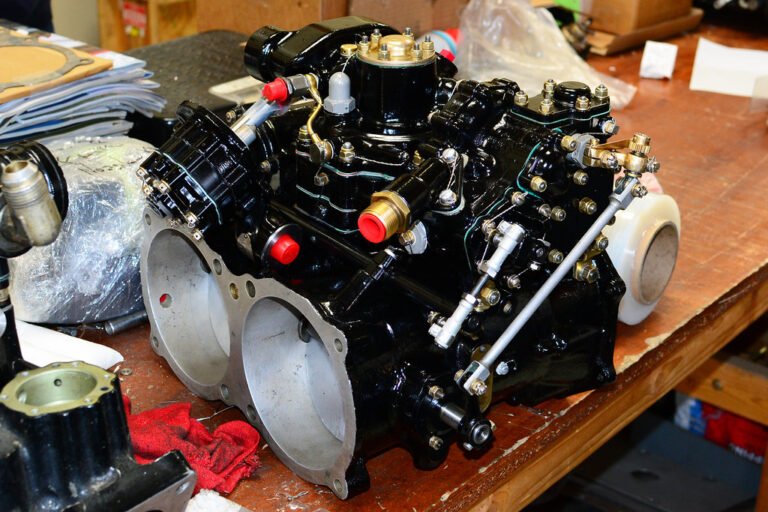How to Adjust a Two Stroke Carburetor
To adjust a two-stroke carburetor, locate the idle and mixture screws. Turn them to achieve optimal engine performance.
Adjusting a two-stroke carburetor ensures your engine runs smoothly and efficiently. The process involves fine-tuning the idle speed and fuel mixture for optimal performance. Proper adjustment can prevent engine stalling, improve fuel efficiency, and extend the lifespan of your engine.
Start by locating the idle and mixture screws on the carburetor. Carefully turn these screws while monitoring the engine’s response. Small adjustments can make a significant difference in performance. Regular maintenance and correct adjustments are crucial for keeping your two-stroke engine in top condition. This guide provides a straightforward approach to help you adjust your two-stroke carburetor effectively.

Introduction To Two-stroke Carburetor Tuning
Tuning a two-stroke carburetor is crucial for optimal performance. A well-tuned carburetor ensures your engine runs smoothly. It also enhances fuel efficiency and reduces emissions.
The Importance Of Proper Carburetion
Proper carburetion is vital for engine performance. It ensures the right air-fuel mixture. A balanced mixture prevents engine damage. It also improves throttle response and power output.
An incorrect air-fuel mix can lead to poor performance. It may cause engine overheating or stalling. This could result in costly repairs.
Basic Principles Of A Two-stroke Carburetor
A two-stroke carburetor mixes air and fuel. The mixture then goes to the engine. The carburetor has several parts, including:
- Throttle Valve: Controls air intake.
- Needle Valve: Regulates fuel flow.
- Jets: Provide fuel at different engine speeds.
Understanding these parts helps in tuning. Adjustments are made using screws on the carburetor. These screws are usually labeled:
| Screw | Function |
|---|---|
| Idle Screw | Adjusts engine idle speed. |
| Low-Speed Screw | Controls fuel mix at low speeds. |
| High-Speed Screw | Regulates fuel mix at high speeds. |
Adjusting these screws fine-tunes the air-fuel mix. This helps achieve optimal engine performance.
Tools And Materials Needed For Carburetor Adjustment
Adjusting a two-stroke carburetor can seem daunting. With the right tools and materials, it becomes manageable. This section outlines the essential tools and safety precautions for a successful adjustment.
Essential Tools For The Job
Here is a list of essential tools you will need:
- Screwdrivers: Both flathead and Phillips screwdrivers.
- Socket Wrench Set: Various sizes for different parts.
- Carburetor Adjustment Tool: Specific for your carburetor model.
- RPM Gauge: To monitor engine speed.
- Clean Cloth: For wiping down parts.
- Fuel Line Clamp: To prevent fuel spills.
Safety Precautions And Best Practices
Follow these safety precautions to ensure a smooth process:
- Wear Safety Gear: Use gloves and eye protection.
- Work in a Ventilated Area: Ensure good airflow.
- Secure the Engine: Prevent it from moving during adjustment.
- Disconnect the Spark Plug: Avoid accidental starts.
- Handle Fuel Safely: Use a fuel line clamp to avoid spills.
These best practices will help you stay safe and work efficiently.
Identifying The Carburetor Adjustment Screws
To properly tune a two-stroke engine, you must identify the carburetor adjustment screws. These screws control the air-fuel mixture and engine speed. Correct adjustments ensure your engine runs smoothly and efficiently.
Function Of The Idle Screw
The idle screw controls the engine’s idle speed. This screw adjusts the amount of fuel entering the engine at idle. Turning the screw clockwise increases the idle speed. Turning it counterclockwise decreases the idle speed.
Follow these steps to adjust the idle screw:
- Start the engine and let it warm up.
- Locate the idle screw on the carburetor.
- Turn the screw slowly while listening to the engine sound.
- Adjust until the engine runs smoothly at idle.
Roles Of The High And Low Speed Screws
The high speed screw affects the engine’s performance at full throttle. The low speed screw impacts performance at lower speeds. Adjusting these screws correctly is crucial for engine health.
Here’s a table summarizing their functions:
| Screw | Function |
|---|---|
| High Speed Screw | Controls fuel mixture at full throttle |
| Low Speed Screw | Controls fuel mixture at low speeds |
Adjusting these screws involves:
- Locating the high and low speed screws on the carburetor.
- Turning the high speed screw to find optimal full throttle performance.
- Adjusting the low speed screw for smooth low-speed operation.
Proper adjustment ensures the engine runs efficiently at all speeds.
Preparing The Engine For Adjustment
Before adjusting a two-stroke carburetor, you must prepare the engine. This ensures accurate tuning and optimal performance. Follow these steps to get your engine ready for adjustment.
Warming Up The Engine
Start by warming up the engine. A cold engine may not give accurate readings. Run the engine for 5-10 minutes. Make sure it reaches its normal operating temperature. This helps in getting reliable adjustment results.
Ensuring A Stable Operating Environment
Ensure the engine is in a stable environment. Avoid windy or dusty areas. These conditions can affect the engine’s performance. Place the engine on a flat, stable surface. This prevents any movement during adjustment.
Check for any loose parts. Tighten any screws or bolts. This ensures the engine remains stable. Use a table to keep track of necessary tools:
| Tool | Purpose |
|---|---|
| Screwdriver | Adjusting screws |
| Wrench | Tightening bolts |
| Clean cloth | Wiping parts |
Wear safety gear. Use gloves and goggles. This protects you from any mishaps.
- Ensure the area is well-ventilated.
- Keep a fire extinguisher nearby.
- Have a first aid kit ready.
Following these steps ensures a safe and effective adjustment process. Proper preparation leads to a well-tuned engine.
Adjusting The Idle Speed Screw
Adjusting the idle speed screw on a two-stroke carburetor is crucial. It ensures your engine runs smoothly and efficiently. This guide will help you find the perfect idle setting and troubleshoot any idle issues.
Finding The Ideal Idle Setting
Locate the idle speed screw on your carburetor. It usually sits near the throttle linkage. Turn the screw clockwise to increase idle speed. Turn it counterclockwise to decrease idle speed.
Start your engine and let it warm up. Adjust the screw until the engine runs smoothly. Listen for a steady, rhythmic sound. If the engine sputters or stalls, tweak the screw slightly.
Use a tachometer for precise adjustments. Aim for the RPM recommended by the manufacturer. Check your engine manual for these details.
Troubleshooting Idle Issues
Idle issues can arise from various factors. Common problems include dirt in the carburetor, improper fuel mixture, or worn-out parts.
First, check the air filter. A dirty filter can restrict airflow, causing idle problems. Clean or replace the filter if needed.
Next, inspect the fuel mixture. Ensure the fuel is fresh and mixed correctly. Old or incorrect fuel can affect engine performance.
If the engine still idles poorly, examine the carburetor. Look for dirt or debris in the jets and passages. Clean the carburetor thoroughly to remove any blockages.
Check for worn-out parts like gaskets or seals. Replace them if they show signs of wear. This can often resolve lingering idle issues.

Tuning The Low-speed Mixture Screw
The low-speed mixture screw is crucial for a two-stroke engine. It affects the idle speed and throttle response. Proper tuning ensures smooth operation.
Achieving The Perfect Low-speed Mix
To achieve the perfect low-speed mix, follow these steps:
- Warm up the engine to its normal operating temperature.
- Locate the low-speed mixture screw on the carburetor.
- Turn the screw clockwise until it lightly seats.
- Turn the screw counterclockwise 1.5 turns as a starting point.
- Adjust the screw in small increments, clockwise or counterclockwise.
- Listen for the engine’s RPM to stabilize and idle smoothly.
- Stop adjusting once the engine idles smoothly without sputtering.
| Adjustment | Engine Behavior |
|---|---|
| Too Rich (Counterclockwise) | Engine stumbles or runs rough |
| Too Lean (Clockwise) | Engine hesitates or stalls |
| Optimal | Engine idles smoothly and responds well |
Signs Of Improper Low-speed Adjustment
Recognize signs of improper adjustment to maintain engine health. Look for:
- Hesitation or Stalling: Indicates a too lean mixture.
- Rough Idle: Suggests a too rich mixture.
- Poor Throttle Response: Shows the need for fine-tuning.
Correct these issues by readjusting the low-speed mixture screw. Ensure the engine idles smoothly and responds well to throttle input.
Fine-tuning The High-speed Mixture Screw
Adjusting the high-speed mixture screw on a two-stroke carburetor is crucial. This process ensures your engine runs smoothly at high speeds. Proper adjustments can improve performance and prevent damage.
Optimizing High-speed Performance
To optimize high-speed performance, you need to adjust the high-speed mixture screw. Follow these steps:
- Start your engine and let it warm up.
- Turn the high-speed mixture screw clockwise until the engine starts to slow down.
- Then, turn it counterclockwise until the engine runs smoothly.
- Listen to the engine sound to find the sweet spot.
These adjustments ensure that your engine gets the right fuel mixture. This step helps in achieving peak performance.
Safety Tips For High-speed Adjustments
Safety is crucial during high-speed adjustments. Follow these tips to stay safe:
- Always wear protective gear like gloves and goggles.
- Keep a fire extinguisher nearby in case of emergencies.
- Do not make adjustments in an enclosed space.
- Keep children and pets away from the working area.
Following these safety tips can prevent accidents and ensure a smooth adjustment process.
Testing And Final Adjustments
The final step in adjusting a two-stroke carburetor involves testing and making final adjustments. This step ensures your engine runs smoothly and efficiently. Below are detailed steps for conducting a test run and making incremental improvements.
Conducting A Test Run
After making initial adjustments, conduct a test run. Start the engine and let it warm up. Listen for any unusual sounds. Observe the engine’s performance and note any issues.
- Idle Speed: Ensure the engine idles smoothly without stalling.
- Acceleration: Check if the engine accelerates smoothly.
- Smoke Levels: Look for excessive smoke, indicating a rich mixture.
Making Incremental Improvements
Based on your observations, make small adjustments. Use the following guidelines:
- Idle Adjustment: Turn the idle screw to achieve a steady idle.
- Air-Fuel Mixture: Adjust the mixture screw for optimal performance. Turn clockwise to lean the mixture and counterclockwise to richen it.
- Repeat Testing: Conduct another test run and observe changes.
Repeat these steps until the engine performs optimally. Small, incremental adjustments yield the best results.
| Adjustment | Direction | Effect |
|---|---|---|
| Idle Screw | Clockwise | Increases idle speed |
| Idle Screw | Counterclockwise | Decreases idle speed |
| Mixture Screw | Clockwise | Leans mixture |
| Mixture Screw | Counterclockwise | Richens mixture |
Remember, patience is key. Rushing can lead to poor performance. Take your time for the best results.
Common Mistakes To Avoid In Carburetor Adjustment
Adjusting a two-stroke carburetor can be tricky. Many enthusiasts make common mistakes that hinder performance. Knowing these errors helps you avoid them. Here are the most common mistakes and how to steer clear of them.
Over-adjusting The Screws
One big mistake is over-adjusting the screws. Too many turns can mess up the fuel-air mix. This can cause the engine to run poorly. Always adjust screws in small increments.
First, mark the original position of the screws. Turn them slowly, just a quarter turn at a time. Listen to the engine and watch its performance. If the engine sounds worse, return to the original setting.
Neglecting Environmental Factors
Environmental factors play a significant role in carburetor adjustments. Temperature, altitude, and humidity affect engine performance. Ignoring these can lead to improper tuning.
For example, at higher altitudes, the air is thinner. You need less fuel for the same air volume. Adjust the carburetor accordingly. In cold weather, engines need more fuel to run smoothly. Always consider the environment when tuning your carburetor.
Here’s a quick reference table:
| Condition | Adjustment |
|---|---|
| High Altitude | Lean the mix |
| Low Altitude | Rich the mix |
| Cold Weather | Rich the mix |
| Hot Weather | Lean the mix |
Adjusting your carburetor based on these factors ensures optimal performance. Always keep these in mind while tuning your engine.
Maintenance Tips For Sustained Carburetor Performance
Maintaining a two-stroke carburetor is essential for optimal engine performance. Regular upkeep ensures longevity and efficiency. Follow these maintenance tips to keep your carburetor in top shape.
Regular Cleaning Routine
Keeping the carburetor clean is crucial. Dirt and debris can clog the jets and fuel passages. Regular cleaning helps avoid these issues. Here’s a simple cleaning routine:
- Remove the carburetor from the engine.
- Disassemble the carburetor parts carefully.
- Soak parts in a carburetor cleaner solution.
- Use a soft brush to scrub away any residue.
- Rinse parts with clean water and dry thoroughly.
- Reassemble the carburetor and reinstall it on the engine.
Periodic Inspection And Tuning
Regular inspection and tuning ensure the carburetor operates efficiently. Follow these steps for periodic checks:
- Inspect the carburetor for any visible damage or wear.
- Check the fuel lines for cracks or leaks.
- Examine the air filter and clean or replace if necessary.
- Adjust the idle screw to ensure a smooth idle.
- Fine-tune the air-fuel mixture for optimal performance.
Here’s a quick tuning guide:
| Component | Action |
|---|---|
| Idle Screw | Turn clockwise to increase idle speed. |
| Air-Fuel Mixture | Turn clockwise for a leaner mix, counterclockwise for richer. |
Regular maintenance ensures your two-stroke carburetor performs well. Follow these tips to keep your engine running smoothly.
Troubleshooting Post-adjustment Issues
After adjusting your two-stroke carburetor, you may face some issues. These problems can affect the engine’s performance. Let’s explore how to identify and solve these issues.
Identifying And Solving Common Problems
Common problems include engine stalling, poor idling, and lack of power. Below are some ways to address these issues:
- Engine Stalling: Check the fuel mixture. Ensure it’s not too rich or too lean.
- Poor Idling: Adjust the idle screw. Turn it clockwise to increase the idle speed.
- Lack of Power: Inspect the air filter. Clean or replace it if dirty.
| Problem | Possible Cause | Solution |
|---|---|---|
| Engine Stalling | Incorrect fuel mixture | Adjust the mixture screw |
| Poor Idling | Improper idle screw setting | Turn idle screw clockwise |
| Lack of Power | Dirty air filter | Clean or replace the filter |
When To Seek Professional Help
Sometimes, DIY adjustments are not enough. Seek professional help if:
- The engine still stalls after adjustments.
- Poor idling persists despite tuning.
- The engine lacks power even after cleaning the air filter.
Professionals have the tools and expertise to diagnose issues. They can solve complex problems that DIY fixes can’t address.
Conclusion: Maximizing Engine Efficiency
Adjusting a two-stroke carburetor can seem daunting. With proper steps, you can enhance your engine’s performance. A well-tuned carburetor ensures your engine runs smoothly and efficiently. This guide has covered all the essential steps for tuning your carburetor effectively.
Recap Of Key Tuning Steps
Let’s revisit the critical steps in adjusting your two-stroke carburetor:
- Identify the carburetor parts: Locate the idle, low, and high-speed screws.
- Start the engine: Ensure it is warm for accurate tuning.
- Adjust the idle screw: Set a stable idle speed.
- Fine-tune the low-speed screw: Achieve a smooth idle with quick throttle response.
- Calibrate the high-speed screw: Ensure maximum power at full throttle.
- Test the adjustments: Test the engine performance through various speeds.
The Benefits Of A Well-adjusted Carburetor
A properly adjusted carburetor offers numerous advantages:
- Enhanced engine performance: Optimizes power output and throttle response.
- Improved fuel efficiency: Reduces fuel consumption, saving costs.
- Reduced emissions: Lowers harmful exhaust emissions.
- Extended engine life: Prevents engine strain and potential damage.
These benefits highlight the importance of regular carburetor maintenance. Ensure your engine runs at its best by following these tuning steps.
Frequently Asked Questions
How Do You Adjust A Two-stroke Carburetor?
To adjust a two-stroke carburetor, locate the air and fuel mixture screws. Turn the screws incrementally to fine-tune the engine’s performance. Adjust until the engine runs smoothly and efficiently.
What Tools Are Needed To Adjust A Carburetor?
To adjust a carburetor, you’ll need a flathead screwdriver and a tachometer. These tools help you make precise adjustments to the air and fuel mixture.
Why Is My Two-stroke Engine Running Rough?
A rough-running two-stroke engine often indicates an improper air-fuel mixture. Adjusting the carburetor’s screws can resolve this issue, ensuring smooth engine operation.
How Do I Know If My Carburetor Is Too Rich?
A carburetor running too rich will produce black smoke from the exhaust. Adjust the air-fuel mixture screws to lean out the mixture and eliminate the smoke.
Conclusion
Mastering two-stroke carburetor adjustment ensures optimal engine performance. Regular maintenance prevents issues and boosts longevity. Follow these steps for smooth operation and efficiency. Adjusting your carburetor correctly will save time and money. Enjoy a well-tuned engine and a better riding experience.
Happy tuning!

At AdjustCarburetor, we are passionate about optimizing engine performance and sharing our expertise in carburetors, small engines, fuel injection systems, air-fuel ratios, and ignition timing solutions





One Comment